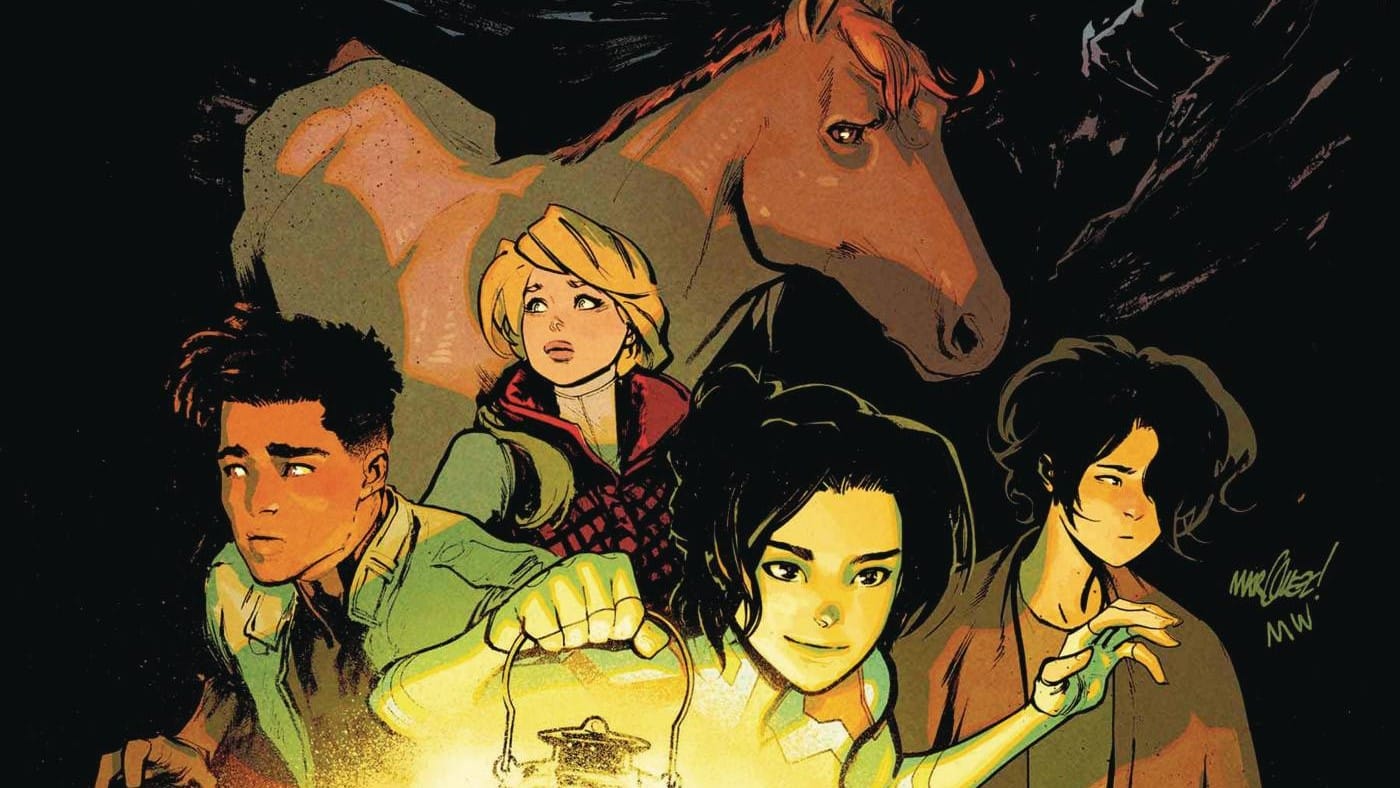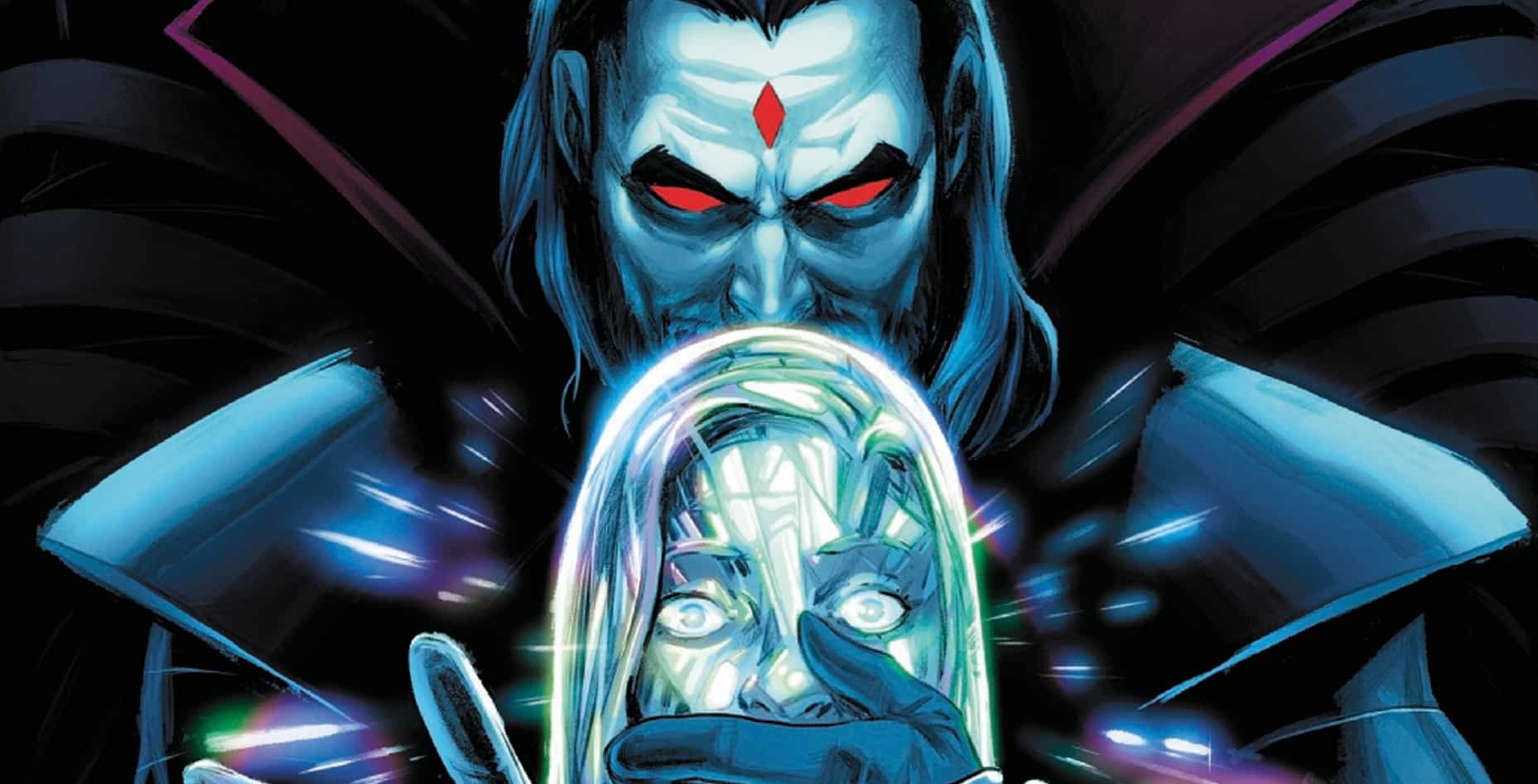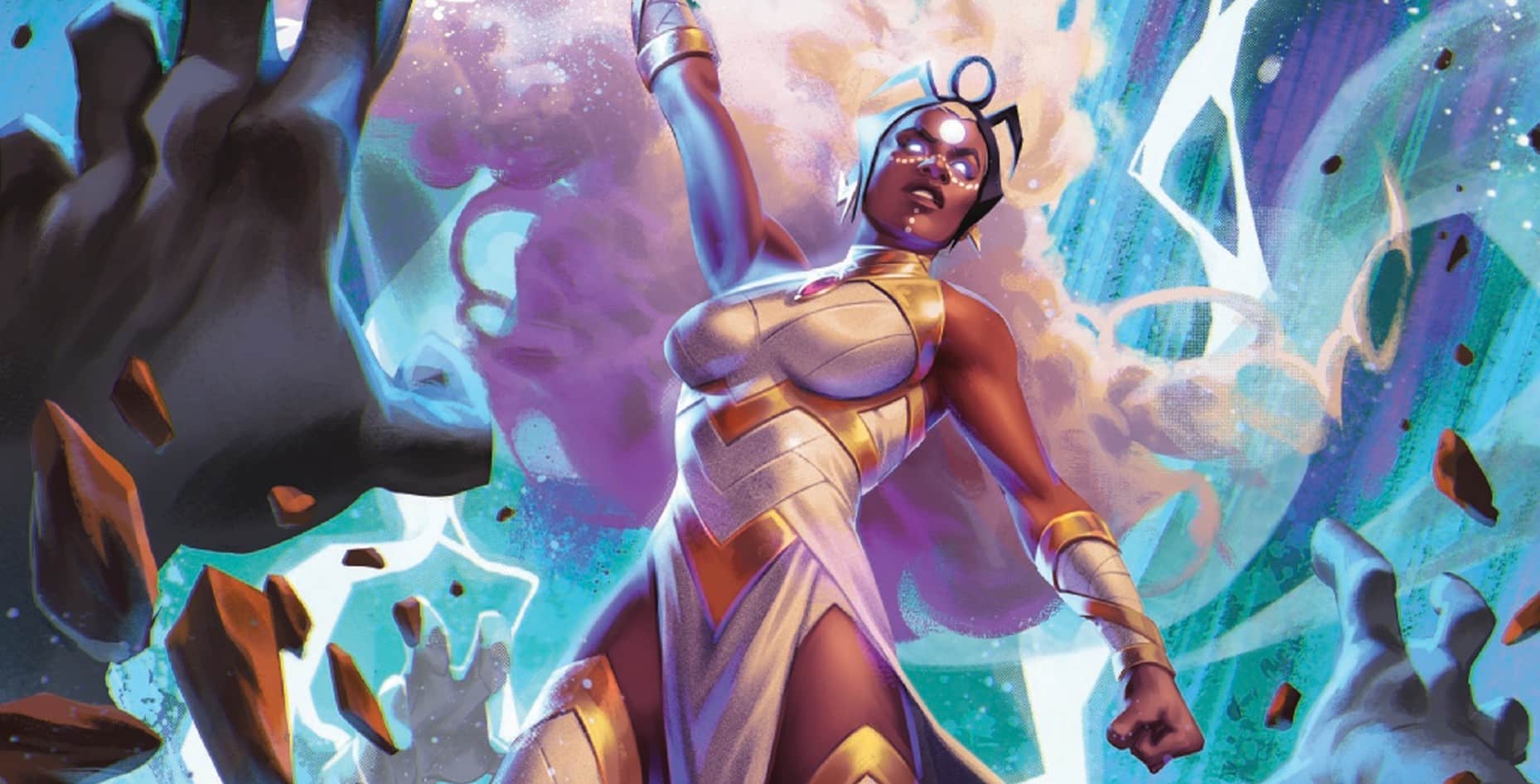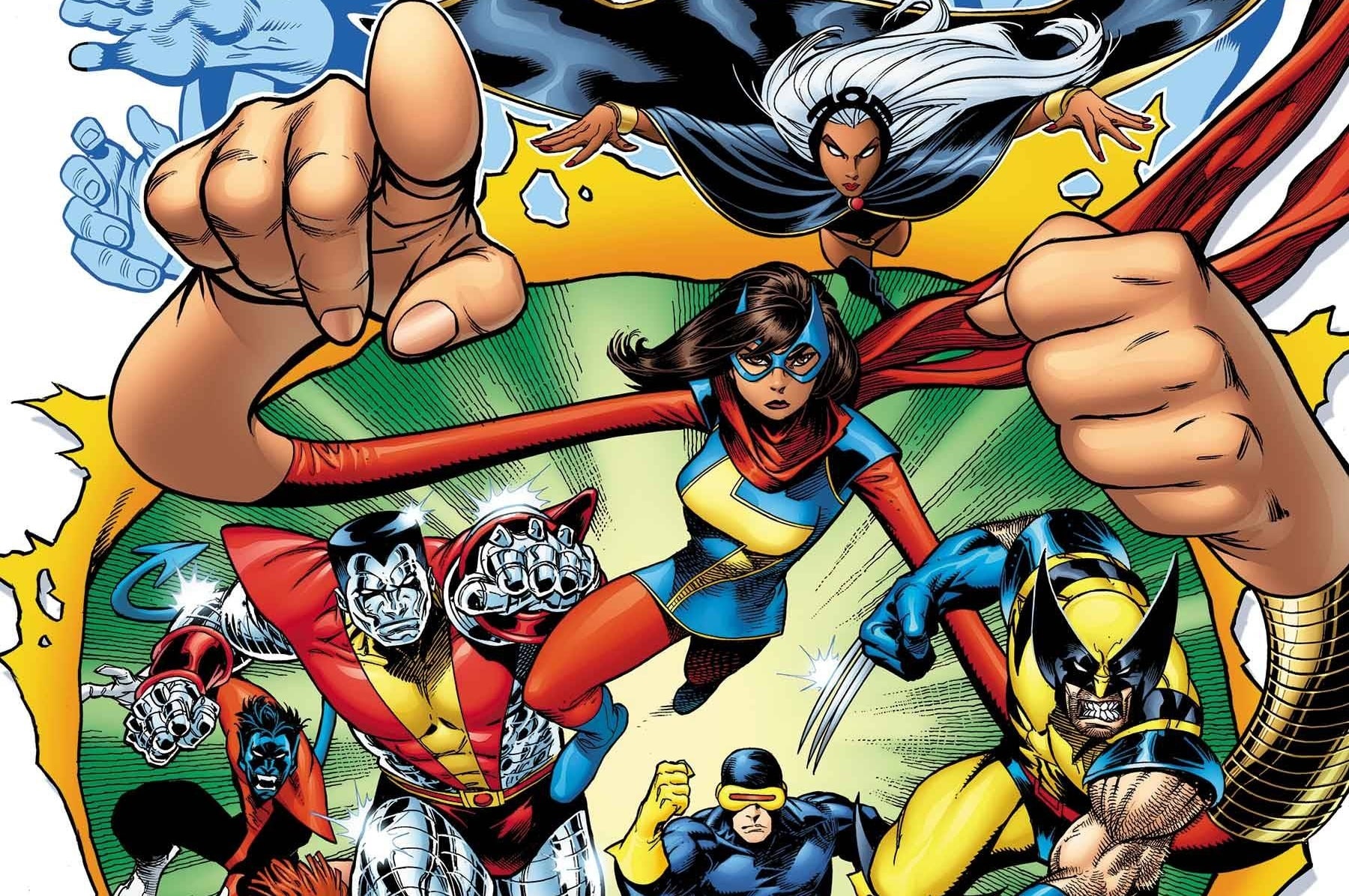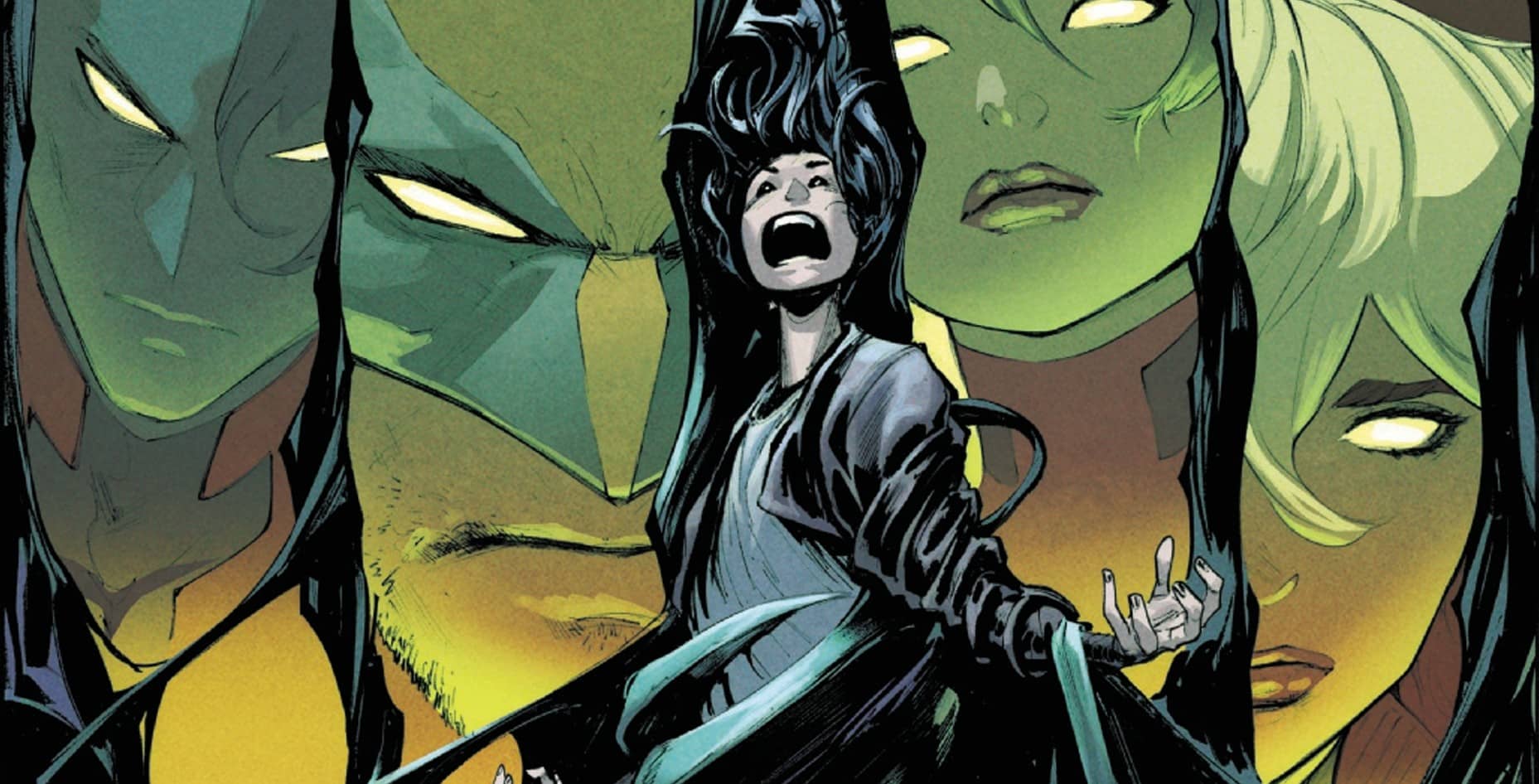In their most terrifying adventure yet, the four young Outliers discover the true meaning of Haven House and a doorway that should never be opened. Meanwhile, an otherworldly presence has set its covetous eye on one of the four young mutants, in a story that tells a never-before-told slice of the history of mutantkind. Uncanny X-Men #13 is written by Gail Simone, drawn by David Marquez, colored by Matt Wilson and lettered by Clayton Cowles.
Adam Reck: Austin, a mere week ago we were talking about a fairly enjoyable issue of Uncanny starring the ragin’ Cajun himself, Gambit. And now, in spite of myself, we’re back yet again to talk about another issue of this series that — dare I say — I actually liked?!
Austin Gorton: I hesitate to call “all clear” or attribute a streak of [checks notes] two as a trend, but it feels like the book has turned something of a corner now that “X-Manhunt” and, reportedly, the new schism among the X-Men are done. It also helps, of course, that kickoffs are easier to land than conclusions.
Adam: I want to be clear, I have some major reservations. And we’ll get into them. But this book is so much better when Gail Simone stops pretending it’s about an X-team and just follows Gambit, the Outliers and actually delivers on the Southern Gothic premise she’s promised. Plus, David Marquez is back and he’s drawing all kinds of pretty.
Austin: I remain mixed as to whether I, personally, want Southern Gothic X-Men, but it’s a distinct POV and I definitely want books to have that. This series has consistently been at its best when it leans into that instead of trying to retread “Schism.”
Remy and the T-rex

Adam: One thing we know people want? Rogue and Gambit sexy cuddling! And this is the second issue in a row to show these two disrobed in the night. Unfortunately for Gambit, he has a rendezvous with an angry dragon and some hungry hungry dinos.
Austin: Kudos to Simone for not leaving this “Gambit steals a dragon’s gold” plotline simmering too long. And while it may seem repetitive to have two issues in a row built around the concept of someone calling in a debt against Gambit, it’s actually a smart bit of plot construction.
One of the things we liked about the Vig last issue was how relatively low stakes and self-contained it was. But by doing that story in succession with this one, the repetition raises the stakes; Gambit can’t just cleverly nullify this debt like he just did; instead, he ends up in the Savage Land.
Adam: I don’t think I’ve ever seen Marquez draw a dinosaur before, but now that I have, I want them in every issue! His artwork is fantastic throughout this issue, but his T-rexes are boss!
Austin: I am always torn on Savage Land stories. On the one hand, I feel about them the way a lot of people feel about “X-Men in space” stories: They take the characters away from their central metaphor narrative tension. On the other hand, I love dinosaurs, so …
All of which is to say, yes, Marquez draws some great T-rexes. And rather than just have the X-Men pal around in a prehistoric jungle, this whole thing turns out to be an object lesson in the consequences of playing fast and loose with another “vig,” so to speak.
Adam: It also serves as a warning. As our dragon pal munches on a dino, it warns Remy he may develop a taste for human flesh. Yikes! Seems like a pretty good reason to give back that extra Eye of Agamotto, but what do I know?
The Outliers and the Spider-Vein

Adam: What does Gail want? To write an Outliers book! And I’m glad this issue leans into it yet again, following the kids through a swampy bog on a spooky trail to something called the “Dark Artery.” I thought that sounded stupid in the solicit, but seeing it depicted on page as a mystical underground mutant graveyard? That’s kinda rad!
Austin: It continues to amuse me how many X-Men stories are set in underground spaces within the confines of the famously-below-sea-level New Orleans, but this one at least has a mystical component to it.
That aside, a focus on the Outliers goes hand in hand with success in this book, in part because they tie in with the book’s specific POV. Less because they’re distinctly Southern Gothic, but because they’re original to the series (and thus it’s harder to write them out of character compared to the X-Men).
Adam: Also this book ends with a cameo that’s both actually surprising and, when you think about it, not even a little bit surprising.
Austin: Well said. On the one hand, the X-books have been largely self-contained within the larger Marvel Universe for a long time (barring a few exceptions like marrying Iron Man and Emma Frost or the current Laura Kinney: Wolverine series). So seeing a stalwart “weird shit is happening, here comes Man-Thing!” reveal in one of the flagship books is legit surprising.
On the other hand, weird shit is happening! In a Southern Gothic setting involving a mystical location of some kind. Of course Man-Thing is showing up!
Henrietta and the Service

Adam: This issue introduces us to a new character: Henrietta Benjamin, embarking on a train journey from South Chicago to Haven, Louisiana. Henrietta’s name immediately evokes Henrietta Lacks, the African American woman whose “immortal” cells were taken without permission by John Hopkins University while being treated for cervical cancer. Lacks’ unique “HeLa” cells made for a unique and immense contribution to medical research in the 20th century, but the theft without acknowledgement of her cells follows a pattern of medical abuse and misuse of African Americans throughout American history. I highly recommend readers seek out Rebecca Skloot’s The Immortal Life of Henrietta Lacks to learn more about her.
Uncanny’s Henrietta relies on engraved warning symbols by fellow mutant African Americans, here referred to as “Abhorrents” “Moonflyers” or “Johnny Devils,” to guide her way, not unlike Victor Hugo-Green’s Jim Crow era travel guides that helped African Americans find friendly faces and places across the country.
I bring this up for two reasons. One, I think that Simone is doing something fascinating here that I haven’t seen in an X-Men comic before: drawing direct correlations between the mutant metaphor and the painful, historical struggle of Black people in America at the turn of the century in the Jim Crow South. And two, because the story Simone is telling is explicitly that of a Black woman, she risks what many white writers do in trying to be the authors of Black stories: inauthenticity.
Austin: Let’s pause for a moment and just acknowledge that the new historical/cultural terms for mutants are, essentially, more new nicknames.
Purely from the perspective of the X-Men narrative, this is fascinating stuff. There’s a chance this could very well become this series’ most significant contribution to that narrative, far more so than mutant tumors and Graymalkin prison and even the Outliers. It takes the core civil rights metaphor of the X-Men — one that has long been wedded to the specific contours of the 1960s Civil Rights Movement for better and worse — and stretches it back along the trajectory of U.S. race relations and opens up a whole new angle for the metaphor.
It’s just one issue. There’s more story to come, and plenty of potential for pitfalls. Plus no guarantee the story itself will lead to bigger things and/or not get memory holed as soon as it’s done. But for now, it’s probably the most interesting idea to be floated in the From the Ashes era.
Adam: There is so much potential here. The “Mutant M” that seemed so stupid in the X-Men’s present has a much more poignant quality when contextualized like it is in this issue. We don’t often hear about marginalized groups in quite this way throughout the history of X-Men. But I am really worried. This book has not shown a thoughtfulness about what it means to cast a Black woman as the owner/operator of a federal prison, or a Black lab tech as the person who sicced robot attack dogs on children, so I’m not ready to give it the benefit of the doubt. Especially when Luciano Vecchio’s upcoming variant cover for Uncanny #14 sure makes it look like Henrietta may actually be yet another villain of color (though that remains to be seen) in a book that doesn’t need another one.
Austin: I share your concerns. The potential for something good is there, but so is the potential for something awful. You’re absolutely right that this book, in its short life, does not have a good track record when it comes to characters like Podcaster Ellis. And all else aside, the fastest way to pigeonhole any of the fascinating suggestions here of a Jim Crow-era mutant subculture is to tie it to a character who turns out to be nothing more than a villain du jour who looks like an H.R. Giger-designed Southern belle.
Adam: Given the speed this book comes out at, we won’t be waiting long to find out!
X-traneous Thoughts
- A pirogue has nothing to do with Rogue. It’s essentially a Cajun canoe.
- Lots of sleepwear in this issue; Ransom also gets a PJ shot when the Outliers wake him up.
- That the Dark Artery looks like a big obsidian X is a nice touch.
- After obliquely teasing it earlier, Simone definitely seems to be setting up a Calico/Jitter romance. Curious how far the current regime will let her take that.
- Calico’s freakout (“how can there be a graveyard under a swamp?”) is a great example of how strong Simone’s writing of the Outliers is.
- Hopefully, Jacob Miller of “the Service,” whom Henrietta meets getting off the train and clearly doesn’t like “moonfliers,” will end up being the true villain of the story. Seems like he could be part of some kind of proto-Friends of Humanity anti-mutant group.
Buy Uncanny X-Men #13 here. (Disclaimer: As an Amazon Associate, ComicsXF may earn from qualifying purchases.)

